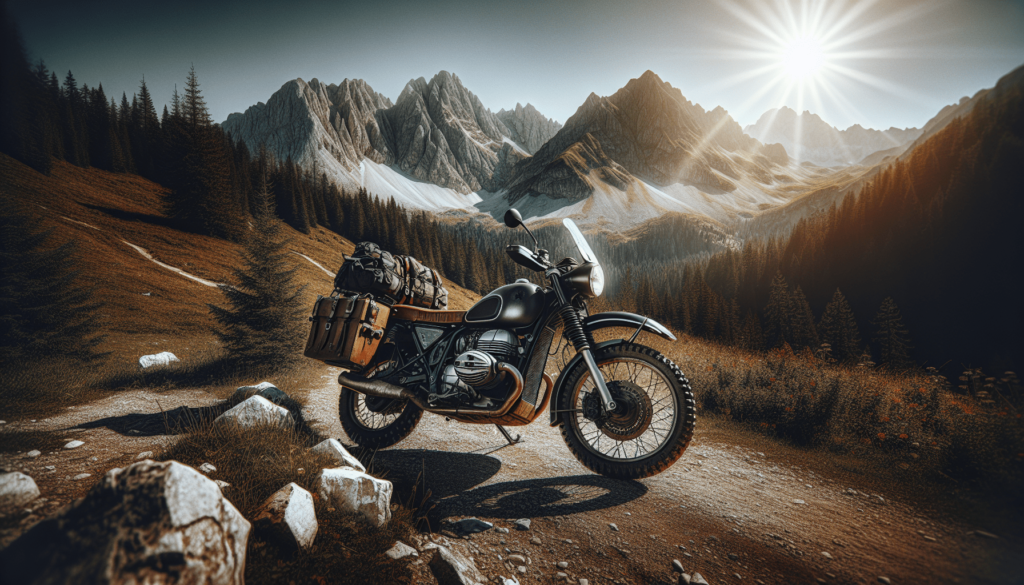So you’ve always had a passion for adventure and a love for motorcycles, and now you can’t help but wonder: how do I overland on a motorcycle? If exploring breathtaking landscapes, tackling rugged terrains, and immersing yourself in the great outdoors sound like the ultimate experience to you, then you’re in for a thrilling ride. In this article, we will explore the ins and outs of motorcycle overlanding, from the essential gear you’ll need to the tips and tricks for planning your epic journey. Get ready to discover a whole new world of adventure on two wheels!
Choosing the Right Motorcycle
Consider the Terrain and Distance
When it comes to embarking on an overland adventure on a motorcycle, choosing the right bike is essential. One of the first factors to consider is the terrain you’ll be navigating. Are you planning on traversing rugged mountains, sandy deserts, or smooth highways? Different motorcycles are designed to handle different terrains, so make sure to choose one that is suitable for the type of riding you’ll be doing.
Another important consideration is the distance you’ll be covering. Long journeys necessitate a motorcycle with a comfortable seating position and efficient fuel consumption. If you’re planning to travel short distances, a more nimble and lightweight bike might be preferable. Understanding the terrain and distance of your journey will help you make an informed decision on the type of motorcycle that will best suit your needs.
Balance Comfort and Durability
Comfort and durability are two crucial factors to weigh when selecting a motorcycle for overlanding. Remember, you’ll be spending long hours in the saddle, so it’s crucial to choose a bike that offers a comfortable riding position. Look for motorcycles with adjustable handlebars, well-padded seats, and ergonomic designs to minimize fatigue and discomfort during your journey.
Durability is equally important, as you’ll want a bike that can withstand the challenges of off-road riding and remote conditions. Consider motorcycles with robust suspension systems, sturdy frames, and reliable engines. It’s also a good idea to research the availability of spare parts and mechanical expertise in the areas you’ll be traveling, just in case any repairs or replacements become necessary.
Ensure Adequate Storage Capacity
Overlanding requires carrying essential gear and supplies, so having sufficient storage capacity on your motorcycle is vital. Look for bikes with built-in or add-on storage options such as panniers, top cases, or saddlebags. These allow you to pack and organize your belongings efficiently, making it easier to access items when needed.
Before choosing a motorcycle, consider the type and amount of gear you’ll be carrying. If you plan on camping, you’ll need space for a tent, sleeping bag, cooking equipment, and other outdoor essentials. On the other hand, if you’re planning on staying in accommodations along the way, you may require less storage space. Evaluate your needs and choose a motorcycle with adequate storage to accommodate all your gear comfortably.
Preparing the Motorcycle
Perform Regular Maintenance
Before setting off on your overland journey, ensure that your motorcycle is in top-notch condition by performing regular maintenance. Regularly check the brakes, clutch, chain, and sprockets for any signs of wear and tear. Change the oil and filter as per the manufacturer’s recommendations, and check the fluid levels of your coolant, brake fluid, and oil. Don’t forget to inspect and replace the air filter if necessary.
Additionally, keep an eye on your motorcycle’s tire pressure and tread depth to ensure optimum performance and safety. Regular maintenance not only enhances your motorcycle’s longevity but also helps prevent breakdowns or mechanical issues during your trip. If you’re unsure about performing maintenance tasks yourself, consult with a professional mechanic to ensure your motorcycle is ready for the adventure ahead.
Check Tires and Suspension
When it comes to overlanding on a motorcycle, having well-maintained tires and suspension is crucial for a smooth and safe ride. Before hitting the road, inspect your tires for any signs of damage or excessive wear, and replace them if necessary. Ensure that the tire pressure is adjusted according to the manufacturer’s specifications for the best traction and control.
Additionally, check the condition of your motorcycle’s suspension system. Over time, the suspension may become worn or lose its effectiveness. Consider getting your suspension serviced or upgraded to ensure optimal performance, especially if you’ll be encountering rough or uneven terrain during your journey. Properly functioning suspension enhances your motorcycle’s stability, comfort, and overall handling capabilities.
Upgrade Lights and Electronics
When venturing on an overland journey, it’s important to consider the lighting and electronic systems on your motorcycle. Upgrading your lights to high-quality LED bulbs or auxiliary lights can significantly improve visibility, particularly during nighttime or adverse weather conditions. This not only enhances your safety but also reduces eye strain and fatigue, ensuring a more enjoyable riding experience.
Additionally, consider installing a GPS system or smartphone mount on your motorcycle to aid navigation. With a reliable navigation system, you can easily follow your planned routes, discover alternate paths, and locate points of interest or attractions along the way. Such upgrades can greatly enhance your overall enjoyment and convenience on your overland adventure.

Planning Your Route
Research Road Conditions and Traffic Laws
Before embarking on your motorcycle overland journey, conduct thorough research on the road conditions and traffic laws of the areas you’ll be traveling through. Familiarize yourself with local traffic regulations such as speed limits, helmet laws, and any specific requirements for motorcyclists. Understanding these laws will ensure you ride safely and avoid any potential fines or legal issues.
Additionally, research the road conditions of the areas you’ll be traversing. Are there any construction or maintenance zones to be aware of? Will you encounter unpaved roads, gravel, or challenging terrains? By understanding the conditions, you’ll be better prepared, both mentally and physically, to navigate the challenges that lie ahead.
Consider Scenic Routes and Attractions
One of the joys of motorcycle overlanding is the opportunity to experience breathtaking landscapes and discover hidden gems along the way. Consider planning your route to include scenic routes or attractions that align with your interests. Whether it’s mountain passes, coastal roads, or historic sites, these detours can add an element of excitement and adventure to your journey.
Research online travel forums, guidebooks, or local recommendations to identify must-see attractions or off-the-beaten-path locations. Be prepared to be flexible with your itinerary, as unexpected discoveries or recommendations from fellow riders can often lead to the most memorable experiences. Remember, overlanding is about embracing the journey and immersing yourself in the beauty and culture of the places you visit.
Plan for Potential Challenges and Delays
No matter how thoroughly you plan your route, it’s important to remember that unexpected challenges and delays can arise during an overland journey. Prioritize flexibility and be prepared for unforeseen circumstances such as road closures, mechanical issues, or adverse weather conditions. Carry extra provisions, be patient, and maintain a positive attitude in the face of challenges.
Allow for buffer time in your itinerary to account for potential delays. This will help reduce stress and enable you to adapt to changes in your plans without feeling rushed. Embrace the unpredictable nature of overlanding, as it often leads to the most memorable and rewarding experiences.
Packing Essential Gear
Clothing and Protective Gear
Proper clothing and protective gear are crucial when embarking on a motorcycle overland adventure. Invest in a sturdy and durable motorcycle jacket, pants, and boots that provide adequate protection against abrasion and impact. Additionally, ensure you have a well-fitting helmet that meets safety regulations.
Layering is key when it comes to clothing for long rides. Pack lightweight base layers that wick away moisture, mid-layers to provide insulation, and waterproof outer layers to protect against rain or cold weather. Don’t forget to pack extra gloves, socks, and a neck gaiter to adapt to changing weather conditions.
Camping Equipment
If you plan on camping during your overland journey, packing the right camping equipment is essential. Invest in a quality tent that is lightweight, easy to set up, and spacious enough for your needs. Consider a sleeping bag designed for the temperatures you expect to encounter, as well as a sleeping pad or air mattress for added comfort.
Other camping essentials include a portable stove or cooking system, cookware, and utensils. Don’t forget to pack a water filtration device or purification tablets to ensure a reliable source of clean drinking water. Remember, efficient and lightweight camping gear will make a significant difference in your overall comfort and enjoyment.
Tool and Repair Kits
No matter how reliable your motorcycle is, it’s wise to carry a basic tool and repair kit to handle any minor issues that may arise during your journey. A compact toolkit should include essential tools such as wrenches, screwdrivers, pliers, and a tire repair kit. Familiarize yourself with basic maintenance tasks such as chain adjustment and oil changes, and pack the necessary supplies and spare parts.
Additionally, consider carrying a tire inflator or portable air compressor, as well as a can of puncture sealant. These items can help you address any tire-related issues quickly and efficiently, allowing you to continue your journey with minimal downtime.

Navigating with Maps and GPS
Carry Paper Maps as Backup
While relying on GPS or smartphone apps is convenient and efficient, it’s important to have a backup in case of battery failure or technological issues. Carrying paper maps of the areas you’ll be traveling through can be a lifesaver when it comes to navigating unfamiliar terrain. Familiarize yourself with the map symbols and legends, and highlight your planned route and alternative options.
Paper maps also provide a tangible connection to the land and can enhance your overall experience by allowing you to physically trace your route and mark significant milestones along the way. They also become cherished mementos of your journey once you return home.
Use GPS Devices or Smartphone Apps
In this digital age, GPS devices and smartphone apps have revolutionized navigation for overlanders. These technologies offer real-time mapping, turn-by-turn directions, and the ability to track your progress along the route. They can also provide valuable information such as nearby gas stations, restaurants, or lodging options, making it easier to plan stops along your journey.
Invest in a reliable GPS device specifically designed for motorcycle use, ensuring it is waterproof and has a long battery life. Alternatively, utilize smartphone apps that offer offline maps, turn-by-turn directions, and other useful features for navigation. Remember to download the necessary maps and updates before setting off, as mobile data may not be readily available in some remote areas.
Familiarize Yourself with Navigation Functions
Whether you choose to navigate with paper maps, GPS devices, or smartphone apps, taking the time to familiarize yourself with the navigation functions is crucial. Practice using the devices or apps before your journey to ensure you understand how to input waypoints, plan routes, and interpret the information provided.
Understanding the navigation functions will help you avoid wrong turns, identify alternative routes, and navigate efficiently even in challenging or intricate road networks. The more familiar you are with your chosen navigation method, the more confident and stress-free your journey will be.
Safety and Security
Observe Traffic Rules and Local Customs
Safety should always be a top priority when overlanding on a motorcycle. Respect traffic rules and regulations in the areas you’ll be traveling through, and always ride defensively. Be aware of local customs and driving habits, as these may differ from what you’re accustomed to. Observing and adapting to the local traffic culture will help you blend in and minimize any potential conflicts or misunderstandings.
Remember to use hand signals or indicators to communicate your intentions to other road users, and always ride within your limits. Stay vigilant, anticipate potential hazards, and prioritize your safety and the safety of others.
Carry First Aid and Emergency Supplies
Accidents can happen, even to the most experienced riders. Carrying a comprehensive first aid kit is essential to address minor injuries or provide initial care until professional medical help can be reached. The first aid kit should include items such as adhesive bandages, antiseptic solutions, gauze pads, and pain relief medication.
In addition to the first aid kit, consider packing emergency supplies such as a flashlight, a multi-tool, a whistle, and a reflective safety vest. These items can prove invaluable in situations where you need to attract attention or perform emergency repairs. It’s always better to be prepared and have the necessary supplies readily available.
Protect Your Motorcycle from Theft
Protecting your motorcycle from theft is crucial, especially when traveling in unfamiliar areas. Invest in a sturdy and reliable lock to secure your bike when it’s parked and unattended. Consider using a chain or cable lock that can be attached to immovable objects, such as a lamp post or bike rack, to deter potential thieves.
It’s also a good idea to cover your motorcycle with a weatherproof cover when it’s parked overnight or during extended stops. This not only protects your bike from the elements but also makes it less conspicuous and less likely to attract unwanted attention. Taking simple precautions can go a long way in ensuring the security and peace of mind during your overland journey.
Managing Fuel and Food
Plan Fuel Stops along Your Route
One of the most critical aspects of motorcycle overlanding is managing fuel consumption. Before setting off, plan your fuel stops along your route. Identify gas stations or filling stations at regular intervals to ensure you never run out of fuel in remote or desolate areas.
Keep in mind that fuel availability can vary depending on the regions you’re exploring. Some areas may have limited or sporadic gas stations, so consider carrying extra fuel in appropriate containers to extend your range. Research the distance between fuel stops to calculate your needs accurately, and always err on the side of caution.
Carry Extra Fuel Containers
Carrying extra fuel containers provides an added level of security and flexibility during your overland journey. Depending on the range of your motorcycle, carrying additional fuel can allow you to explore more remote areas or make detours without worrying about running low on fuel.
When choosing fuel containers, opt for durable and leak-proof options specifically designed for carrying fuel. Ensure they are securely fastened to your motorcycle, away from any sources of heat or flames. Additionally, familiarize yourself with local regulations regarding the transportation of fuel to ensure compliance with any relevant restrictions or safety guidelines.
Pack Non-perishable Food and Snacks
As an overlander, it’s crucial to pack non-perishable food and snacks to sustain yourself during long riding days or in situations where food options are limited. Items such as energy bars, trail mix, canned goods, and dehydrated meals are lightweight, easy to store, and require minimal preparation.
Prioritize food items that provide a good balance of nutrients and calories, ensuring they can be easily consumed on the go if necessary. Aim for a variety of options to prevent meal fatigue and to cater to different dietary preferences or restrictions. Packing non-perishable food and snacks ensures you always have sustenance available and minimizes reliance on finding food in unfamiliar locations.
Camping and Accommodation
Look for Campsites and Wild Camping Spots
Camping is often a popular choice for motorcycle overlanders, offering a sense of freedom and the opportunity to connect with nature along the way. Research campsites along your route and plan stops accordingly. National parks, state parks, and other designated camping areas often provide facilities such as toilets, showers, and potable water.
If you enjoy wild camping and prefer a more secluded experience, research the regulations and opportunities for dispersed camping in the areas you’ll be traveling through. Always adhere to Leave No Trace principles and obtain any necessary permits or permissions before setting up camp. Remember to pack a lightweight camping stove or cooking system, cookware, and utensils for preparing meals in the great outdoors.
Consider Homestays or Budget Accommodations
While camping offers a unique experience, you may also consider staying in homestays or budget accommodations along your journey. Homestays provide an opportunity to connect with locals, learn about their culture, and experience their way of life. They often offer a more immersive and authentic experience compared to traditional accommodations.
Budget accommodations such as guesthouses or hostels can provide a comfortable and affordable option, especially during extended overland trips. Research online travel platforms, local directories, or forums to find recommendations for budget-friendly places to stay along your route. Prioritize locations that offer secure parking for your motorcycle, ensuring both your personal belongings and your bike are safe.
Connect with Fellow Overlanders for Tips
Overlanding on a motorcycle is a community-driven activity, and connecting with fellow riders can provide valuable insights and tips for your journey. Engaging with online forums, social media groups, or attending motorcycle meetups can help you find like-minded individuals who share your passion for exploring the world on two wheels.
Fellow overlanders can offer practical advice on routes, accommodations, sights to see, and cultural experiences to seek out. They can also provide valuable information on road conditions, border crossings, and other logistical considerations. By tapping into this collective knowledge, you can enhance your overland journey and build lasting relationships with fellow adventurers.
Dealing with Challenging Weather
Prepare for Rain and Cold Conditions
Weather conditions can change quickly, and it’s crucial to be prepared for rain and cold when traveling on a motorcycle. Pack waterproof gear such as rain jackets, pants, and boot covers to stay dry during wet weather. Ensure your motorcycle gear has integrated or removable waterproof layers to protect against moisture.
For colder conditions, layering is key to staying warm. Consider packing thermal base layers, insulating mid-layers, and windproof outer layers to trap heat and protect against chilly winds. Don’t forget to pack warm gloves, a hat, and a neck gaiter to prevent heat loss from your extremities.
Pack Adequate Layering Options
Being prepared for varying temperatures and weather conditions is essential during an overland journey. Pack versatile clothing options that can be layered to accommodate shifting temperatures. This allows you to regulate your body temperature effectively, ensuring comfort and convenience throughout your ride.
Opt for clothing made from quick-drying and moisture-wicking materials to prevent sweat from accumulating and causing discomfort. Multi-purpose garments such as convertible pants or jackets with removable sleeves provide added flexibility, allowing you to adapt to changing weather conditions easily.
Seek Shelter or Alternative Accommodations
In situations where weather conditions become severe or dangerous, it’s important to prioritize your safety. Seek shelter or alternative accommodations if riding conditions become hazardous. This may involve adjusting your route, finding nearby lodging, or waiting out the worst of the weather before continuing your journey.
Research possible stopping points such as towns or cities along your route where you can find accommodations if necessary. Familiarize yourself with emergency contact numbers and locations of medical facilities to ensure you can access help if needed. Remember, safety should always be your top priority when facing challenging weather conditions.
Developing a Maintenance Routine
Perform Regular Chain Maintenance
The chain is one of the most critical components of your motorcycle, and regular maintenance is necessary to ensure optimal performance and longevity. Clean and lubricate the chain at regular intervals to prevent rust, corrosion, and excessive wear. Use a specifically designed chain cleaner and a suitable lubricant to maintain smooth operation and minimize friction.
Regularly inspect the chain for tight or loose spots, as this can affect your motorcycle’s performance and handling. Check for any signs of damage or wear, such as kinks, stiff links, or excessive slack. If you notice any issues, consult with a professional mechanic or refer to your motorcycle’s user manual for guidance on adjusting or replacing the chain.
Keep Cleaning Supplies On Hand
Motorcycle overlanding can expose your bike to various elements, from dust and mud to saltwater and grime. Regular cleaning is essential for maintaining your motorcycle’s appearance and preventing long-term damage to its components. Keep cleaning supplies on hand, including bike-specific cleaners, brushes, microfiber cloths, and a hose or water source.
After each day of riding, take the time to rinse off any accumulated dirt or debris from your motorcycle. Focus on areas such as the wheels, brakes, and engine, as these are more prone to collecting grime. Follow up by applying a recommended cleaner and using brushes or cloths to gently remove stubborn dirt. Regular cleaning not only keeps your motorcycle looking its best but also allows you to identify any potential issues before they become major problems.
Inspect and Tighten Fasteners Regularly
Vibrations and constant use can cause fasteners on your motorcycle to become loose over time. Regularly inspect and tighten critical fasteners such as bolts, nuts, and screws that secure various components. Pay specific attention to areas such as the handlebars, mirrors, footpegs, and luggage mounting points.
Carry a small toolkit with appropriate wrenches and screwdrivers to perform these routine inspections and adjustments. Additionally, consider investing in a torque wrench to ensure specific fasteners are tightened to the manufacturer’s recommended specifications. Regularly tightening fasteners not only prevents components from becoming loose or detached during your journey but also reduces potential damage caused by excessive vibrations.
By following these tips and guidelines, you can confidently embark on your motorcycle overland adventure. Remember to choose the right motorcycle for your intended terrain and distance, prepare your bike adequately, plan your route well, pack essential gear, navigate with maps and GPS, prioritize safety and security, manage fuel and food, consider camping and accommodation options, handle challenging weather, and develop a regular maintenance routine.
With careful planning and preparation, you’ll be able to fully immerse yourself in the joys of motorcycle overlanding, discovering new horizons, and creating lasting memories along the way. So, gear up, hit the road, and enjoy the thrill of exploration on two wheels!

